No.3  May 2007 May 2007 | ||
 |
Crop Prospects and Food Situation | |
|
Regional reviews
North Africa Unfavourable prospects for 2007 wheat crop, sharply reduced harvest in Morocco Harvesting of the 2007 winter cereal crops is due to start from June in most countries of North Africa. Although precipitation improved in April, the outlook for the subregion’s aggregate wheat and barley crops is poor due to insufficient soil moisture at planting and subsequent erratic rains in several growing areas. In Morocco, the most affected country, wheat production is forecast to drop by over 50 percent, to the lowest level of the past five years. In Algeria and Tunisia, reductions in area planted and yields due to inadequate rains during the season are expected to result in lower crops compared to last year. In Egypt by contrast, the outlook is favourable, mainly for the irrigated wheat crop, although production is forecast lower than last year’s bumper crop. Overall, FAO forecasts the subregion’s aggregate wheat output at 14.5 million tonnes, 22 percent down from the good crop of 2006 and below average. Production of barley is put at 3.2 million tonnes, a decrease of over 28 percent. 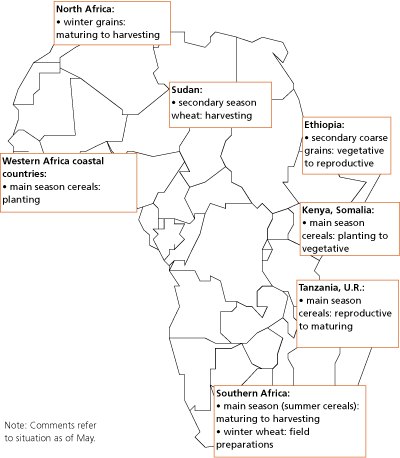
Western Africa Overall food supply situation remains satisfactory but localized food difficulties persist in several countries In western Africa, rains started in March in the southern parts of the coastal countries, allowing sowing of the first 2007 maize crops due for harvest from July. Planting of coarse grains will progress northwards in these countries following the onset of the rains. By contrast, seasonably dry conditions prevail in the Sahelian zone where bumper crops were harvested last year. Following the release of the final production figures, the 2006 aggregate cereal production in the nine Sahelian countries was estimated at a record 15.1 million tonnes, slightly higher than the previous year’s crop and 19 percent above the average of the previous five years. Reflecting two consecutive bumper harvests, markets are well supplied and cereal prices continue to follow the normal trend in most countries. However, localized food security problems persist in several areas due mostly to lack of access or civil strife. In Chad, the worrying security situation in the eastern part of the country is disrupting marketing activities, limiting the flow of commodities between regions and leading to food price spikes in some areas. The continuing population displacement may also affect land preparation for the 2007 cropping season due to start in May. In Mauritania, Niger and Burkina Faso localized populations, already suffering the effects of reduced production in recent years, have yet again had poor harvests because of adverse weather, and their food security situation remain precarious. Food insecurity is also reported in parts of Guinea-Bissau due to marketing disruptions. In Senegal, where insufficient rainfall and inadequate supply of inputs resulted in a 33 percent drop in cereal production compared to the previous year, low supply and increasing prices of millet and sorghum continue to be reported in most regions. However, in areas with high consumer population such as Dakar, Saint-Louis, Thiès and Kaolack, higher purchasing power and effective demand have meant that markets are better supplied both with domestic production and imports. It has been reported that the millet price has dropped by 10 percent in March in Saint-Louis. Since prices are increasing more rapidly in rural areas, vulnerable groups in areas that have experienced sharp declines in production, or were affected by other shocks, need to be continuously monitored and assisted as necessary. Emergency food assistance continues to be also needed in Côte d’Ivoire, Guinea, Liberia and Sierra Leone for large numbers of IDPs and refugees as a result of civil conflicts. Central Africa Food insecurity persists due to civil strife Satellite imagery indicates that the rainy season started on time in the south, allowing land preparation and sowing of the first 2007 maize crop, due for harvest from July. Planting of coarse grains will progress northwards following the onset of the rains. In Central African Republic, persistent insecurity continues to hamper farming activities and large-scale population movements both within the country and to neighbouring countries are reported, notably in the north. Nearly 200 000 people are in need of urgent food assistance according to WFP. Eastern Africa Early prospects for the 2007 cereals crops favourable despite slow start to season in parts In Eastern Africa, the 2007 main season cereal crops are at different stages, from planting to maturing, except for Ethiopia, Eritrea and Sudan where sowing is not due to commence until late May-June. In Kenya, the 2007 long-rains season is well advanced in the main growing areas. Planting prospects have improved with a significant increase in precipitation in past weeks. Delayed onset of the long rains, coupled with late harvesting of the previous short rains crop due to the continuation of unseasonable rains well into February, resulted in reduced planting in March and April. The recent good rains have also benefited north-eastern pastoral areas but moisture deficits are reported in south-eastern parts. In Somalia, good rains in the second decade of April benefited planting of the 2007 main “Gu” crops, which is underway. However, current displacement of population due to the recent escalation of the civil conflict is likely to reduce the area planted, particularly in areas surrounding Mogadishu. Following heavy rainfall in the Ethiopian highlands, water levels of the Shabelle River are rising and a moderate flood warning has been issued. In Uganda, abundant rains in the second dekad of April improved prospects for planting of the 2007 first season in southern bi-modal areas, where field operations had been delayed by dry weather in March. Precipitation was also good in the main producing areas of the north where sowing begins from April. In the United Republic of Tanzania, well distributed seasonal rains across much of the country provided favourable growing conditions for the 2007 maize crop, which in the grain basket region of the southern highlands is due for harvest from mid-May, and in the bi-modal northern production areas is at the reproductive stage. Pasture conditions and water levels in dams across the country have also improved significantly. Harvesting of the 2006/07 secondary season crops is completed in most countries of the region except in Ethiopia, where the “belg” crop is scheduled to be harvested from June. The outlook is favourable following normal to above-normal rainfall during the season in the producing areas of the south-western Ethiopian highlands. The availability of pasture and water in southern and south-eastern pastoral areas has also improved. In Sudan, harvesting of the 2006/07 wheat crop is completed and the output is estimated above average reflecting a sharp increase in plantings in response to sustained demand. FAO’s latest estimate puts the subregion’s aggregate 2006/07 cereal output (main and secondary seasons) at 34.7 million tonnes (including rice in milled terms), about 13 percent above the good level of the previous year and a record high. Table 8. Africa cereal production ( million tonnes)
Note: Totals computed from unrounded data.
Cereal prices well below their levels of a year earlier in most countries Following good 2006 cereal crops in most countries of the subregion, food prices have generally declined since harvest time, except in Ethiopia where they are above their average levels despite a significant increase in production. According to information from the Regional Agricultural Trade Intelligence Network (RATIN), wholesale maize prices are well below their levels of a year ago, although they recovered slightly in April, in Kenya and Uganda. In the United Republic of Tanzania, where the 2007 main season cereal crops are about to be gathered, prices started to decline in March in anticipation of a good harvest (Figures 4 and 5). 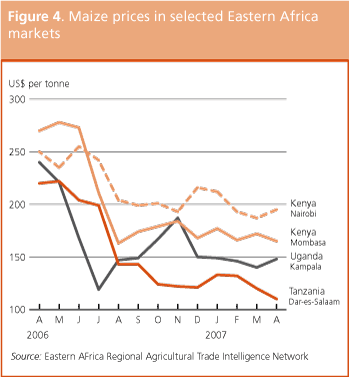
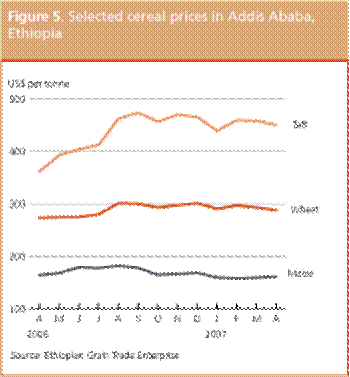
Despite improved food supply millions face serious food difficulties Notwithstanding the general improvement in food supply, millions of people in the subregion face serious food difficulties due to the effects of localized drought conditions and the effects of ongoing and past conflicts. The situation in southern Somalia is of particular concern as the security situation continues to deteriorate (see box). Current estimates of the number of people who are expected to receive food assistance in 2007 in Eastern Africa are given in Table 9. Table 9. Planned Number of People to receive food aid in Eastern Africa (as of end March 2007)
Southern Africa Lower maize harvests in most countries but bumper crop in Malawi In Southern Africa, harvest of the 2007 main season cereal crops is underway. Although the cumulative rains of the 2006/07 season were near normal in most countries, the season was characterized by a late start, excessive precipitation and dry spells of three weeks or longer, causing significant crop losses. In general, northern areas of the region received relatively good rains but southern parts faced extreme dry conditions accompanied by high temperatures. Pending the results of the ongoing FAO/WFP Crop and Food Supply Assessment Missions in Zimbabwe, Lesotho and Swaziland, and production estimates from other countries, the subregion’s aggregate 2007 maize crop is forecast by FAO at about 14.6 million tonnes, slightly lower than the 2006 level and about 7 percent below the five-year average (Table 10). In South Africa, the largest producer of the subregion, the maize harvest is expected to increase 3 percent from last year’s poor level, but to remain about 26 percent below the average of 2002-06. In spite of a recovery in plantings, in response to favourable maize prices, yields were sharply reduced by drought conditions in the main maize growing areas of the country. However, the adverse effects of dry weather have been more marked in the sector of subsistence agriculture where production is expected to decline by one-third from 2006. Unlike last year, the aggregate maize production of the subregion excluding South Africa, is forecast to decline 5 percent from the good level of 2006 but to remain above the average. Smaller cereal crops than last year are expected in most countries of the subregion, except for Malawi and Angola. In Zimbabwe, the Government has declared 2006/07 as a “drought year”, due to erratic and inadequate rainfall. While maize seed availability improved this season, the persisting economic crisis resulted in shortages of fertilizers, mechanical power and human labour. Early forecasts for the maize harvest from different sources point to a significant drop from last year’s good crop. Severe dry weather during the 2006/07 agricultural season has also adversely affected the 2007 cereal harvests in Lesotho and Swaziland. In Madagascar, dry weather and high temperatures in southern parts, where the maize crop is grown, sharply reduced this year’s production, but the main paddy crop is expected to be average. In Namibia, severe flooding in the lowland areas of the important growing Caprivi region resulted in serious crop losses, while dry weather reduced yields in the “maize triangle” around Grootfontein. Official forecasts point to a maize crop one-third below the good level of 2006, but still average. In Zambia, dry weather in southern parts adversely affected maize production but the northern half of the country had abundant rains and good yields are expected in those areas despite localized losses to flood. Overall, the 2007 maize output is expected well below last year’s bumper crop but still at normal to above-normal levels. Similarly, in Mozambique, floods in central parts and severe dry weather in southern provinces reduced maize production in those areas, but in northern areas and in highland areas of the Zambezi Valley good crops are being obtained. The secondary cropping season is also expected to be good after the floods have receded and, in aggregate, this year’s maize crop is forecast to be average although smaller than in 2006. In Bostwana, insufficient and erratic rains during the 2006/07 growing season also resulted in a sharp decline in cereal production from last year but the output is still expected to be average. In Malawi, abundant and well distributed rains, coupled with improved availability of agricultural inputs following a government fertilizer subsidy scheme, are expected to produce another bumper maize harvest this year. Official preliminary estimates indicate a maize crop of 3.1 million tonnes, well above the good level of 2006 and record. As a result, the country will have a large exportable maize surplus in marketing year 2007/08 (April/March). Similarly, in Angola, a good maize harvest is anticipated due to the continuing increase in area planted, following the settlement of returnees, accompanied by favourable rains during this season and improved access to seed and fertilizer. However, excessive rains in central areas and dry weather in southern parts resulted in localized crop losses. Prospects for planting of the 2007 wheat crop and other secondary season crops from May are favourable in northern areas due to late heavy rains resulting in improved soil moisture. In South Africa, which accounts for about 90 percent of the subregion’s wheat production, planting intentions indicate a slight increase in the area which, however, will remain below the five-year average. The increase in plantings reflects higher domestic and international prices since the beginning of the year, as well as the better growing conditions. Table 10. Southern Africa maize production: ( 000 tonnes)
1 Preliminary forecast pending FAO/WFP CFSAM assessments in Zimbabwe, lesotho and Swaziland and other assessments in other countries.
Cereal imports to increase in 2007/08 Reflecting the anticipated lower 2007 maize crops in most countries, the aggregate maize import requirement of the subregion, excluding South Africa, in the 2007/08 marketing year (April/March in most cases) is forecast close to 1.6 million tonnes, up from the previous year’s 1.1 million tonnes (Figure 6). Food assistance requirements for large numbers of people affected by localized floods and dry weather are tentatively projected to increase to about 380 000 tonnes, for maize alone, compared to the estimate of 107 000 tonnes received during 2006/07. This, however, is below the average level of maize food aid received during the previous five years. 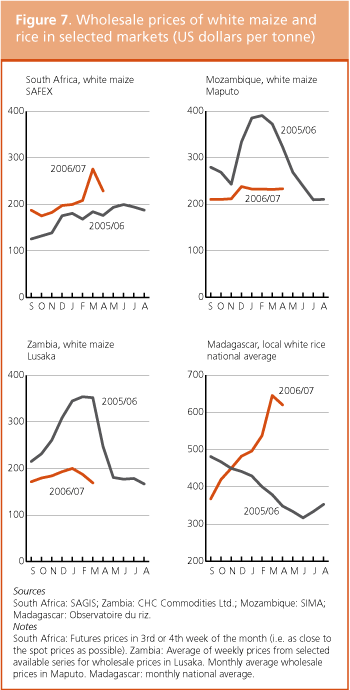
Maize export prices higher than a year earlier in South Africa Export prices of white maize in South Africa (in U.S. Dollar terms), that had been rising since planted time last November, declined in April with the beginning of the harvest but remained well above their levels of a year earlier reflecting a second consecutive poor maize harvest. SAFEX future prices show a positive trend from May till December 2007. High prices in South Africa, the region’s main exporting country, have affected Swaziland, Lesotho and other structural import dependent markets in the region. By contrast, prices of maize in Malawi declined in February and March in anticipation of a record harvest and a potential large exportable surplus. In several other countries of the subregion, current prices of maize, the most important staple food, are also below the corresponding levels a year ago. In Madagascar, sustained heavy rains in past months have disrupted the rice supplies resulting in steep rise in rice prices (Figure 7). Overall, the regional food supply is anticipated to be tighter in marketing year 2007/08 (May/April). In South Africa, official information points to an exportable surplus of white maize (for human consumption) of 587 000 tonnes, well below the level of 2006/07. However, after two consecutive bumper crops, Malawi has emerged as a potential exporter with a large maize surplus. It has been reported that Malawi is negotiating the sale of 400 000 tonnes of maize to Zimbabwe.
Far East Favourable prospects for winter grains Prospects for the winter grain crops (mostly wheat), that are in the latter development stages or nearing harvest throughout the main producing countries remain generally favourable. In China, recent rainfall and warm temperatures have been favourable for the reproductive development of winter wheat and for planting of maize and rice in the major producing area. Current forecasts point to a wheat output of about 99 million tonnes in 2007, close to the five–year average but almost 5 percent lower than last year. The wheat area was reduced as a result of dry weather during the planting season and early growing period. In India, reflecting continuing favourable weather, the 2007 wheat output forecast has been revised up to 73.5 million tonnes. This would be 6 percent up from last year reflecting area expansion and favourable weather during most of the growing season. As a result, wheat imports in 2007/08 are forecast to be much lower at 2 million tonnes, compared to 6.5 million tonnes in the previous marketing year. Similarly, the forecast for Pakistan’s wheat output this year has also been revised up, by 1 million tonnes, to a record 23 million tonnes, 15 percent above the five-year average. The good results are attributable to increased fertilizer subsidies, allowing farmers to raise application rates, and favourable weather. Given the increase in domestic wheat supplies expected, the country is expected to export some 1.5 million tonnes of wheat in 2007/08. By contrast, a smaller wheat crop is in prospect in Bangladesh due to unseasonably high temperatures during the important winter development period. As a result, the country’s wheat imports in 2007/08 are expected to increase to about 2.8 million tonnes. 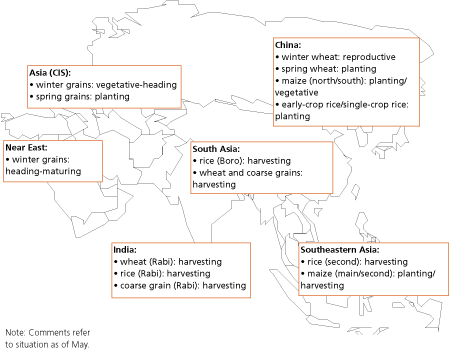
Overall rice prospects are mixed In Indonesia, output of the 2007 main season rice crop, which is already well advanced, is forecast to fall by about 2 percent, following a 3 percent cut in plantings caused by the late arrival of the north-east monsoon rainfall, normally due in September–October, but which only reached the country in December. Harvesting of main Maha season paddy crop in Sri Lanka is complete and output is estimated at an above-average level. Dry season rice prospects in Thailand, Lao People’s Democratic Republic, Cambodia, and Vietnam are generally satisfactory. Food supply difficulties persist in several countries Despite an overall satisfactory food supply situation in the subregion, vulnerable populations in a number of countries are still affected by serious food supply difficulties. The main food security concerns centre on the Democratic People’s Republic of Korea, Nepal, Sri Lanka and Timor-Leste. In the Democratic People’s Republic of Korea, despite an above-average main cereal output in 2006, and generally favourable prospects for the current secondary cropping season, a significant deficit in cereals during the current marketing year (November/October) 2006/07 is estimated. Although the Republic of Korea has recently agreed to provide 400 000 tonnes of rice to its neighbour, some 510 000 tonnes of deficit still remains in 2006/07, which needs to be covered by additional food aid and commercial imports (see box). In Timor-Leste, the 2007 cereal production, including cassava and other tubers, has been severely affected by adverse weather conditions, especially in the northern provinces, where rains have been erratic. Furthermore, crops in some western parts have been affected by an outbreak of locusts. A recent FAO/WFP Crop and Food Supply Assessment Mission has estimated output of maize, the most important crop in the country, to be about 30 percent below the average of the last few years. Although the tight food supply situation experienced in February and March, following disruption of normal importing and marketing activities, is reported to have eased somewhat in April, it is estimated that emergency food aid is needed for about 40 percent of the population. In addition, emergency rice and maize seed assistance is needed for the second crop season, starting in May. A detailed analysis of the food supply and demand situation by the recent Mission will be available soon. Table 11. Asia cereal production ( million tonnes)
Note: Totals computed from unrounded data.
The 2007 wheat crop in Nepal, normally accounting for some 22 percent of total cereal production, is being harvested. Following excellent growing conditions this season, production has been estimated, by a recent FAO/WFP Crop and Food Supply Assessment Mission, at a record 1.46 million tonnes, about 7 percent above the average of the past five years. However, food insecurity is still a big concern for the households severely affected by last year’s droughts, especially in the worst-affected districts of the Eastern region, where crop losses amounted to 25 percent on average and over 40 percent in some districts such as Siraha and Saptari. Due to low productivity and poor market access, many households in the Far-Western and Mid-West regions are extremely poor and suffer from chronic food shortages. Many households in Terai (plain) are also vulnerable to food insecurity as a result of civil strife and chronic poverty. WFP has started and emergency operation to provide food assistance in Far-Western and Mid-West regions since January 2007. In Sri Lanka, despite a record crop gathered last year, the food situation in the northeast of the country is still significantly affected by the deterioration of the security situation. In the Philippines, despite an overall satisfactory food supply situation, recent conflict between the rebel Moro National Liberation Front (MNLF) and the Government has reportedly displaced more than 45 000 people, raising concerns over their food security. In China, the Sichuan province has been affected by strong winds and hail storms in mid-April, with a devastating effect on the agriculture. About 38 000 hectares are reported to be affected to varying degrees. There is concern over the food security of the affected population. Near East Generally favourable outlook for 2007 crops about to be harvested In the Near East, the 2007 main winter cereal crops, mainly wheat, are about to be harvested. Favourable weather conditions since the beginning of the season have been reported for several countries. The overall status of winter crops at the end of March was rated close to the previous year, when an average crop was obtained. Recent reports on the desert locust situation indicate that as a result of unusually good rains during April, desert locust swarms have laid eggs in the interior of Saudi Arabia, along both sides of the Red Sea and in the interior of Yemen. Survey and control operations are urged to be maintained in affected countries. In Iraq, the deteriorating humanitarian situation continues to affect the entire population with civilians bearing the brunt of the violence and insecurity that is disrupting lives and livelihoods in many parts of the country. According to the United Nations High Commissioner for Refugees (UNHCR), some 50 000 people leave Iraq every month seeking refuge. Overall, nearly 1.8 million are internally displaced and 2 million have fled to neighbouring countries. In Afghanistan, recent flash floods from torrential rains and fast snow-melt, following a sudden rise in temperatures, have caused significant damages to lives and livelihoods in most regions of the country. However, despite localized damage, overall prospects are favourable for this year’s cereal production, and aggregate cereal output (rice in milled terms) is now forecast at about 4.9 million tonnes, which is considered above average. Asian CIS Another good cereal harvest forecast this year In the Asian CIS region prospects for 2007 cereal production remain favourable following a mild winter, adequate soil moisture and slightly above average snow cover in the mountainous areas of the region, ensuring sufficient irrigation water throughout spring and summer. Torrential rains and floods have caused some localized damages in parts of the region, which does not affect the forecast cereal output estimated at just under 30 million tonnes, some half a million tonnes up on last year’s good harvest. Kazakhstan is the largest cereal producer in the region accounting for 55 percent of the region’s total output and nearly 95 percent of its production is planted in spring under extensive rain-fed conditions. Kazakhstan has become a significant player in the international grain market and is seeking new markets in the Near East, North and East Africa. The forecast cereal output in the region includes some 24.8 million tonnes of wheat and about 4.6 million tonnes of coarse grains, mainly barley and maize.
Central America and the Caribbean Good start of the 2007 main rainy season In Mexico, harvesting of the 2007 main season irrigated wheat crop, accounting for some 90 percent of the annual production, is well advanced. As a result of adequate water supplies in the north-western producing states of Sonora and Baja California, a good crop is expected for the second consecutive year. Mexico is the sole producer of wheat in the subregion and latest official forecasts indicate an output of about 3 million tonnes, close to the level of last year’s same season. Sowing of the 2007 main season coarse grains and paddy crops has started or is about to start in the subregion. Normal to above-normal rains in April in most countries provided adequate soil moisture for planting and early prospects are favourable. In particular, in Haiti and Dominican Republic, good precipitation since March favoured an early start of the main season maize crop and benefited other foodcrops in the ground. The subregion’s aggregate 2006 cereal production is estimated at 37 million tonnes, higher than in the previous year and above average. Good cereal crops were obtained in most countries, except in Nicaragua affected by dry weather, and in Costa Rica due to lower plantings. In Haiti the overall food security situation is reported to have improved with the good 2006 first and second season harvests and a general improvement of the economic situation. Prices of basic food by the end of March were stable or declining. By contrast, in Honduras, Guatemala and Nicaragua, prices of main staple maize have been increasing since December reflecting higher quotations in the international markets. 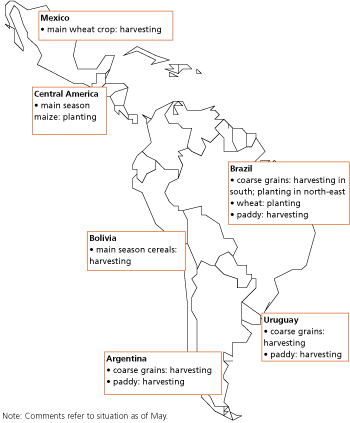
South America Record 2007 coarse grain output Harvesting of the 2007 main season coarse grain crops is well advanced in the main producing southern countries of the subregion. Record or above-average crops are being gathered in most countries. FAO’s latest forecast puts the subregion’s aggregate coarse grain production, mainly maize, close to 90.5 million tonnes, 22 percent above the average level of 2006 and the highest on record. This reflects an increase of 6 percent in the area planted in response to strong demand for ethanol production, and record yields. In Argentina, despite excessive rains and floods in late March and April, recent official forecast point to a record maize production of 22 million tonnes, 52 percent above last year’s level, due to an increase of 11 percent in plantings and record yields. In Brazil, the output of the main season maize crop is expected at 36 million tonnes, 16 percent more than the 2006 same season. Early prospects for the second season maize crops, now being sown, are promising with record plantings anticipated in response to increased international prices; the output is projected to increase by one-quarter to 14 million tonnes. A record 2007 maize crop is also being gathered in Chile. In Uruguay, the outlook for a bumper crop this year may not materialize due to heavy floods in early May, reported to be the worst in fifty years, that have displaced thousands of people and severely damaged crops and livestock. Table 12. Latin America and Caribbean cereal production ( million tonnes)
Note: Totals computed from unrounded data.
In Andean countries, severe floods and dry weather reduced the 2007 cereal and potato crops in Bolivia (see box). In Peru, despite overall favourable prospects for this year’s cereal output, frost and hailstorms in mountain areas, where harvest is underway, adversely affected small farmers’ cereal and potato production.
North America Adverse weather brings damage to wheat and delays maize planting The outlook for the 2007 wheat crop in the United States deteriorated in early April following a period of freezing temperatures and storms, a sudden change from earlier warm conditions that had advanced plant growth ahead of normal for the time of year. Although it is still too early to assess the full extent of the damage, early indications point to damage of varying degrees on up to 70 percent of the crop in the major producing central and southern wheat belt. The effects of the adverse weather are reflected in the USDA winter wheat condition ratings, which declined sharply, to 54 percent rated good to excellent, compared to 64 percent in the week before the adverse weather. However, as the situation stands in late April, the overall crop rating remains relatively good compared to the past few years, with very high condition ratings still reported in some states. FAO now forecasts the United States wheat crop at an about-average 55 million tonnes, after a tentative adjustment for the recent damage, based on the information available to date. As of late April, maize planting in the United States was still in its early stages and progressing much slower than last year and the average because of the adverse weather in the first half of the month. However, plenty time still remains for planting if weather conditions improve soon and the maize area is expected to increase sharply in response to growing demand from ethanol producers and for export. According to the USDA Prospective Plantings report of 30 March, the area intended for maize is seen to rise by some 15 percent to 36.6 million hectares, the largest area since 1944. In Canada, planting of the main 2007 grain crops is underway. Late season snowfall is reported to have improved moisture conditions in some areas where dryness prevailed from last year, but some parts, especially southern Saskatchewan would still benefit from more moisture. According the Statistics Canada Planting Intentions report of 24 April, Canadian farmers intend to reduce sharply the area planted to spring wheat (the major cereal), in favour of durum wheat, barley, oats or non-cereals such as canola or field peas, which are expected to generate better returns this year.
Larger cereals crops in prospects but more rains needed for full potential to materialize In the European Union, latest prospects still point to an increase in cereal production in 2007. The aggregate cereal area for harvest in the 27 countries is forecast to be up by 2 percent on the previous year, which combined with expectations for higher average yields because of generally better growing conditions, could result in a growth of 4 percent in the aggregate output. However, with dry and warm conditions prevailing across a large area of northern and central Europe in April, for current forecasts to hold, some good rains will be needed soon in these areas. The countries concerned include France, the EU’s major cereal producer. On current forecasts, France is expected to account for a large part of the increase forecast in the group’s 2007 cereal output, mostly due to increasing its wheat area, and given the likely recovery in yields from drought-reduced levels last year. By contrast to the predominantly dry central and northern parts, the southwest received some helpful rain in the past few weeks. Although hindering spring fieldwork, the precipitation was overall beneficial, improving soil moisture levels and reservoir levels in the Iberian Peninsula where water has been scarce in the past two years especially. Also in the eastern EU countries, recent rains have improved the outlook for the developing cereal crops. Concern had been building earlier in Hungary and Bulgaria over the lack of soil moisture after a particularly dry winter but latest reports indicate that the recent rains should ensure that at least average yields are achieved. 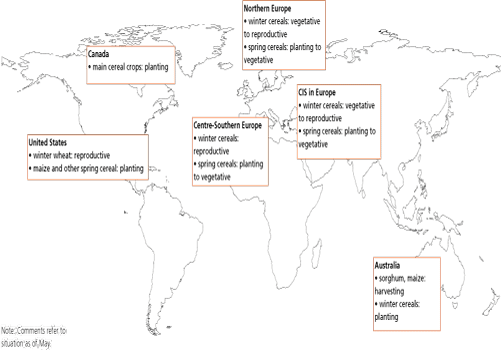
In the European CIS, generally favourable weather conditions, adequate soil moisture and lack of frost in March and April have favoured development of the winter grains and enabled farmers to nearly complete spring cereal planting, almost a month ahead of schedule. This is in contrast to the normal seasonal conditions of cold snaps and frost in March-April, which can often compromise significant areas of winter cereals and delay spring planting. The aggregate area planted with cereals for harvest in 2007 is estimated at about 60.8 million hectares, 1.4 million hectares up on last year. Spring cereals account for more than two-thirds of the aggregate area planted with cereals. Based on the area estimates and the generally favourable growing conditions, the aggregate 2007 cereal output in the subregion is now forecast at about 123.6 million tonnes, nearly 5 million tonnes up on last year. The aggregate output in the subregion this year includes nearly 66 million tonnes of wheat and just over 57 million tonnes of coarse grains, mainly barley and maize. Elsewhere in Europe, the main cereal producing country not in either of the preceding groups is Serbia. Latest information indicates favourable prospects for this year’s production, with increases in both the wheat and maize areas expected. Given good weather conditions for wheat during most of the winter, a sharp increase in output is expected. Current indications also point to a slightly larger maize crop.
Australian farmers anxiously await rains for planting 2007 winter grains Planting of winter grains in Australia is due to start in May. With subsoil moisture at very low levels, the prospects are entirely dependant on the timely arrival of good rains to coincide with the planting window in the main producing areas. Farmers’ planting intentions continue to point to the likelihood of an above-average area if normal seasonal rainfall arrives, by mid-to-end May. On this basis, FAO currently maintains its forecast for a sharp recovery in the country’s wheat output after the drought-reduced output last year. Table 13. North America, Europe and Oceania cereal production ( million tonnes)
1 Eu-25 in 2005, 2006; EU-27 in 2007.
2 In 2007 included in EU-27.
Note: Totals computed from unrounded data.
|
|||||||||||||||||||||||||||||||||||||||||||||||||||||||||||||||||||||||||||||||||||||||||||||||||||||||||||||||||||||||||||||||||||||||||||||||||||||||||||||||||||||||||||||||||||||||||||||||||||||||||||||||||||||||||||||||||||||||||||||||||||||||||||||||||||||||||||||||||||||||||||||||||||||||||||||||||||||||||||||||||||||||||||||||||||||||||||||||||||||||||||||||||||||||||||||||||||||||||||||||||||||||||||||||||||||||||||||||||||||||||||||||||||||||||||||||||||||||||||||||||||||||||||||||||||||||||||||||||||||||||||||||||||||||||||||||||||||||||||||||||||||||||||||||||||||||||||||||||||||||||||||||||||||||||||||||||||||||||||||||||||||||||||||||||||||||||||||||||||||||||||||||||||||||||||||||||||||||||||||||||||||||||||||||||||||||||||||||||||||||||||||||||||||||||||||||||||||||||||||||||||||||||||||||||||||||||||||||||||||||||||||||||||||||||||||||||||||||
| GIEWS | global information and early warning system on food and agriculture |